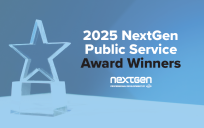For all the success that agencies have had with cloud computing, many experts say that the original clouds did not realize the full potential of cloud computing.
Unquestionably, the first generation (Gen1) of cloud offered many benefits: innovation came from the ability to rapidly spin-up and explore new services; scale came from elasticity; lower costs came from cloud service provider (CSP) “economies of scale” at a level unachievable by agencies’ IT.
Despite this, Gen1 clouds rarely or poorly addressed management and security challenges. The second generation (Gen2) of cloud tackles both problems with automation and groundbreaking security features, said Steve Prescott, Executive Program Director Public Sector at Oracle. Oracle developed a Gen2 cloud which addresses the shortcomings of Gen1 cloud architectures.
Using three lessons, Prescott explained how Gen2 clouds improve upon their predecessors.
1. Reduce Complexity
The Gen1 cloud created several unintended consequences. The IT architectures of these clouds were often static, requiring significant investments in energy, money and time to change.
“First-generation clouds often didn’t make it easy to make changes along the way,” Prescott said.
In comparison to Gen2 clouds, Gen1 clouds required many more skills with much deeper knowledge within those skills. As a result, Gen1 clouds did little to address the proliferation of shadow IT. Shadow IT is any technology used without explicit approval from IT management.
2. Redesign Security
Unfortunately, bad actors in the cybersecurity world are growing in number and in skills. This has resulted in a continuous rise in the number and types of attacks. Consequently, Gen2 clouds must adopt fresh tactics to keep their data safe.
Take hypervisors, which host virtual machines (VMs) that emulate physical computer systems. In recent years, hackers have proven they can break through VMs and exploit hypervisors to access the network of virtual environments that are physically linked together.
Gen2 clouds utilize a technique proven popular and effective at the Defense Department (DoD). The DoD physically separates control over its cloud’s administrative functions from the applications and data that run inside the agency’s cloud environment.
“We created our second-generation cloud with a security-first mentality,” said Prescott. “We want to make sure the government has the proper safeguards in place.”
3. Augment With Automation
Rapid innovation depends on translating innovative thinking into action. Thankfully, automation is a staple of Gen2 clouds that can create more space for creativity and collaboration by carrying out repetitive tasks with little or no human intervention.
For instance, automating tuning, patching and general administrative functions can greatly reduce workloads for an agency’s IT staff.
“We take the day-to-day drudgery of these activities off the shoulders of systems administrators,” Prescott said.
Overall, Gen2 clouds offer agencies automation and simpler, more secure architectures. At agencies that embrace these clouds, the result is workers having the ability to blaze new trails toward mission success.
This article is an excerpt from GovLoop’s recent guide, “Reinventing Government: 20 Innovations for 2020.” Download the full guide here.





Leave a Reply
You must be logged in to post a comment.